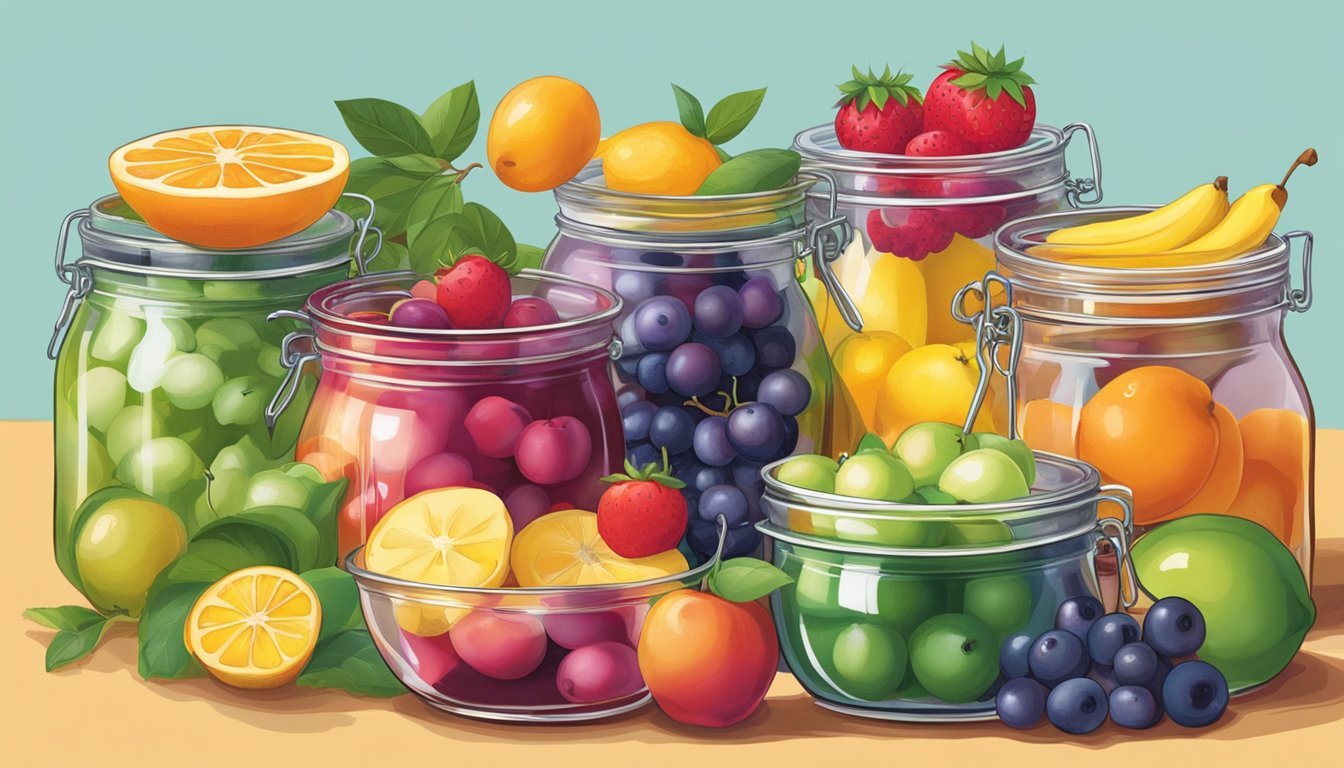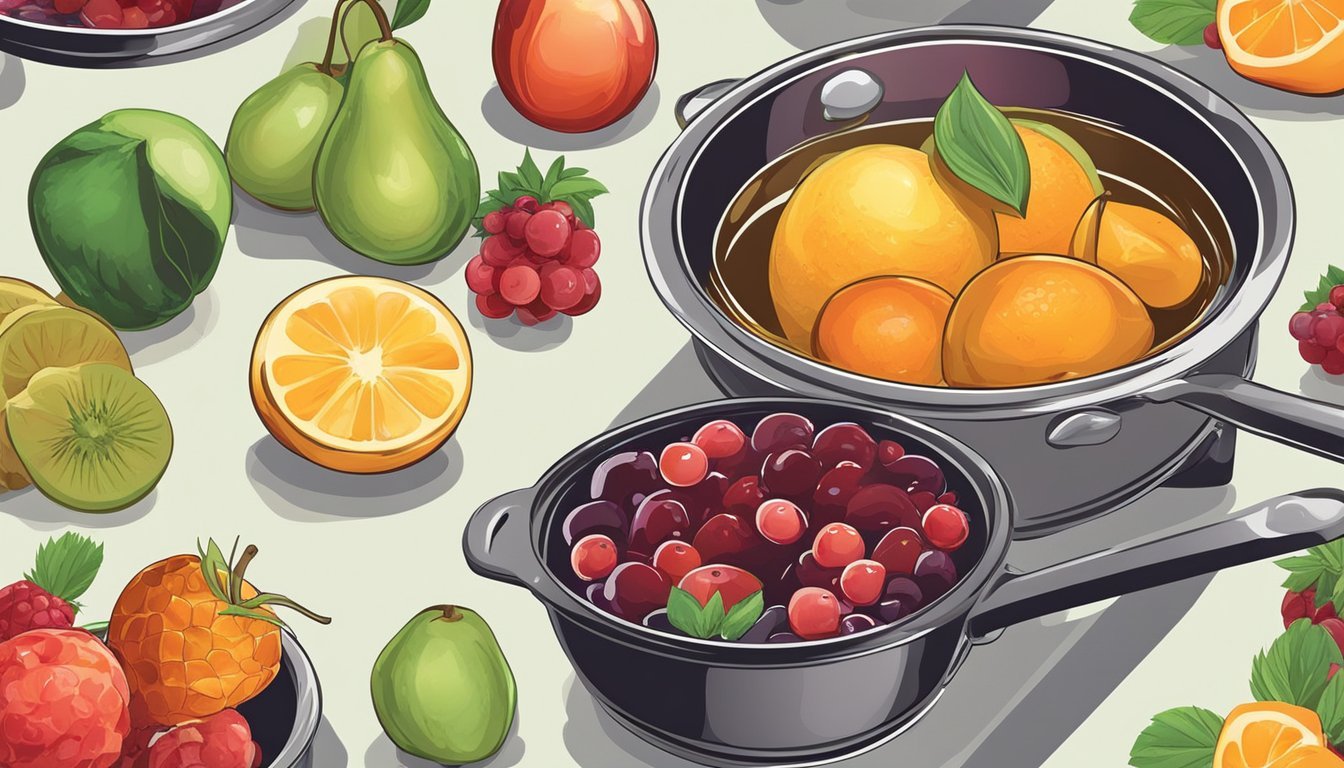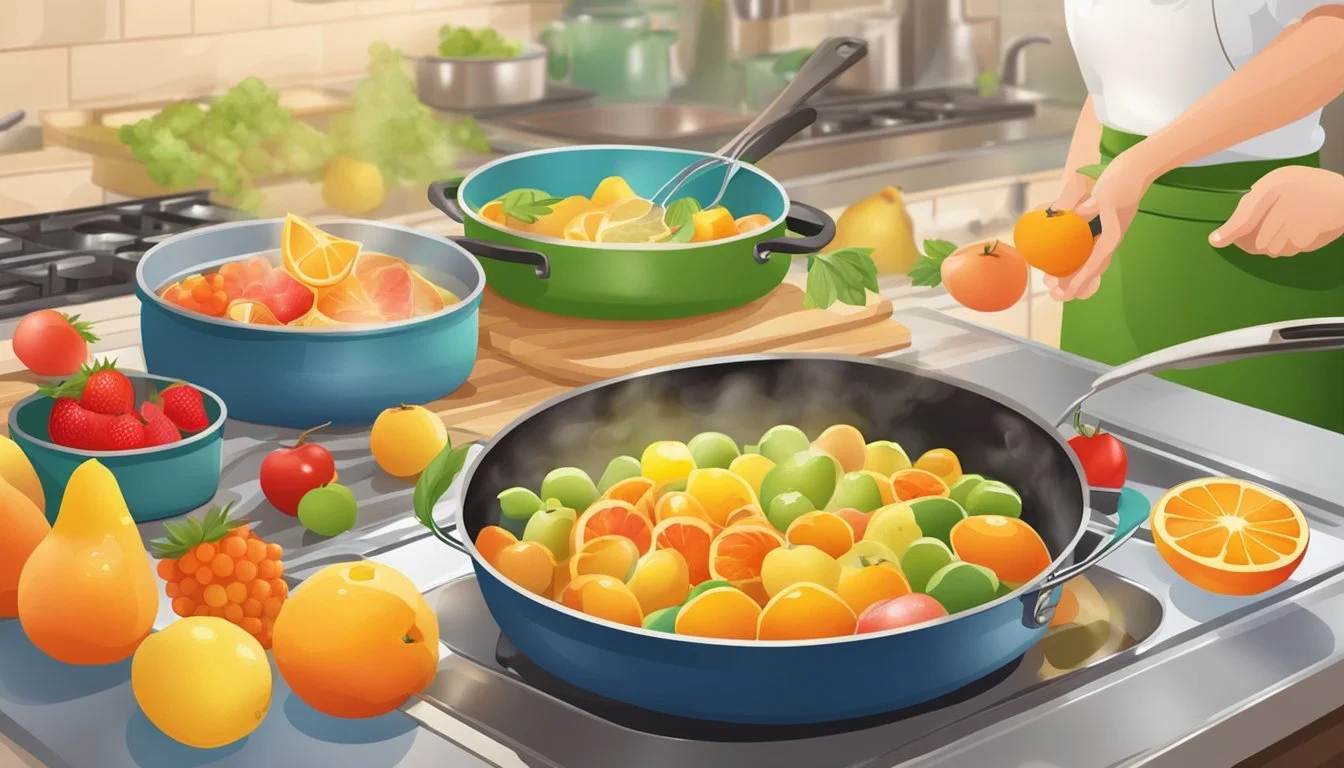The No-Equipment Jam
Crafting Homemade Fruit Spreads Using Only a Pan
Making homemade fruit jam is a delightful way to preserve the taste of the season's harvest. One might assume that creating this sweet spread requires complex tools and ingredients, yet it's entirely feasible to produce exquisite jam with nothing more than common kitchen fruit, a pan, and a few simple additional items. This approach strips the process down to the essentials, favoring a back-to-basics technique that is both accessible and satisfying.
The key to crafting jam without specialized equipment lies in understanding the natural properties of fruit and how they interact with sugar and heat. As fruit cooks in a pan, it releases pectin—a natural thickener found in many fruits (What wine goes well with fruits?)—while sugar not only sweetens the mixture but also helps it gel by drawing out water and concentrating the fruit's natural flavors. A dash of lemon juice often accompanies these ingredients to balance the sweetness with its tartness and to ensure the jam sets properly.
This method is versatile and allows for a range of experimentation, ideal for both novices and seasoned preservers. Whether one chooses berries, stone fruits, or a more exotic combination, the process remains the same: combining the ingredients in a pan and cooking them down to a thick, spreadable consistency. The result is a homemade jam that is full of flavor, with a texture that can only come from the craft of hand-stirring and careful monitoring—the hallmark of a no-equipment approach.
The Basics of Fruit Jams
Making fruit jam relies on understanding the science behind the ingredients and the process. The key to perfect jam is the balance of pectin, sugar, and acidity, applied heat, and the appropriate cooking vessel.
Understanding Pectin and Jam Consistency
Pectin is a natural substance found in fruits that contributes to jam's thickness and structure. While some fruits have high levels of pectin, others have less and may require additional pectin for the jam to set properly. Recognizing the pectin content in fruit is instrumental in achieving the desired consistency without using commercial pectin.
The Role of Heat in Jam Making
Heat is a critical factor in the transformation of fruit into jam. The cooking process involves simmering the fruit on a stovetop to reduce water content, concentrate flavors, and enable sugar to dissolve and interact with pectin. Sufficient heat must be applied to reach the point where the jam will set when cooled.
Choosing the Right Pan for Jam Making
The pan used for making jam significantly affects the final outcome. A heavy-bottomed saucepan is ideal as it distributes heat evenly, reducing the risk of the jam burning. Additionally, the surface area of the pan influences how quickly the jam reaches the setting point. Mason jars are typically used for storing the finished product due to their suitability for preserving and sealing jams effectively.
Preparation and Cooking Techniques
When making jam without specialized equipment, one's focus should shift to the meticulous preparation of fruit and careful cooking. Achieving the desired thickness and flavor requires attention to detail throughout the process.
Preparing the Fruit for Jam
First, one should select high-quality fruit such as strawberries or blackberries, ensuring they are ripe and flavorful. The fruit must be washed, hulled, or pitted as necessary and then mashed or chopped to a desired consistency. For a smoother jam, fruit should be mashed thoroughly; for a chunkier spread, less mashing is required.
Strawberries: Hull and slice; then use a masher for a chunky texture.
Blackberries: Rinse and drain; mash slightly, keeping some whole berries for texture.
Cooking Process and Temperature Control
Cooking jam is a balance of sugar, fruit, and heat. Begin by combining fruit and sugar in a heavy-bottomed saucepan to help prevent burning. The mixture should be stirred over medium heat until the sugar dissolves. Afterward, one should increase the heat to bring the mixture to a rolling boil, essential for the pectin in the fruit to activate and the jam to thicken.
Key Points:
Keep the heat medium to medium-high to aid evaporation and achieve a thicker consistency.
Stir constantly to prevent sticking and to ensure even heating.
Determining Jam's Readiness
One can determine if the jam has reached its setting point through a few techniques. A common method involves chilling a plate and spooning a small amount of jam onto it. After a few moments, if the jam wrinkles when pushed and holds its shape, it is ready.
Testing Thickness: If the jam runs when tilted, continue cooking; if it's slow-moving and holds shape, it's done.
Monitor the cooking closely, as achieving the perfect set requires precise timing.
No-Equipment Jam Recipes
Making jam at home without pectin and special equipment is a straightforward process. These recipes capitalize on the natural fruit pectin and utilize heat, sugar, and natural sweeteners to craft delicious, spreadable goodness.
Simple Berry Jam Recipe
For a classic Simple Berry Jam, one will need just three ingredients:
Berries (strawberries and/or blackberries)
Sugar
Lemon juice
To prepare, they should mash 2 cups of fresh berries in a heavy-bottomed pan to release their juices. For every cup of mashed berries, mix in 3/4 cup of sugar and a tablespoon of lemon juice. They'll cook this over medium heat until the sugar dissolves and then bring to a simmer for about 20 minutes, or until the mixture thickens. It's important to stir frequently to prevent sticking.
Exotic Banana Jam Experiment
The Exotic Banana Jam Experiment offers a unique twist on traditional spreads. One needs:
Ripe bananas
Sugar
Lime juice
With 3 ripe bananas, slice and combine them with half a cup of sugar and the juice of one lime in a saucepan. They should cook the mixture on medium heat, occasionally mashing the bananas as they soften, and let it simmer until it reaches a thick, jam-like consistency, usually about 15 to 20 minutes. This unconventional jam brings a tropical flair to the breakfast table.
Honey-Sweetened Fruit Spread
For those preferring a natural sweetener, Honey-Sweetened Fruit Spread is an excellent choice. This recipe requires:
Fruit of choice (such as strawberries or blackberries)
Honey
Lemon juice
For every cup of fruit, they'll use a quarter cup of honey. After mashing the fruit in a saucepan, they need to stir in the honey and a tablespoon of lemon juice for each cup of fruit. The mixture is cooked on medium heat until the desired thickness is achieved, which should take about 20 minutes, stirring periodically. The honey not only sweetens the jam but also adds a rich, velvety texture.
Storing Homemade Jam
Proper storage of homemade jam extends its shelf life and preserves its flavor. Using suitable containers and storing conditions ensures the jam remains fresh and enjoyable for as long as possible.
Choosing the Right Containers
One must select the right type of containers to keep homemade jam in optimal condition. Glass jars with tight-sealing lids are the most popular choice for their airtight nature and ability to preserve taste and prevent contamination. It's important to sterilize the jars before use by boiling them in water. This eliminates any bacteria that could spoil the jam:
Wash jars in hot, soapy water.
Rinse thoroughly to remove soap residue.
Boil jars for 10 minutes to sterilize.
Once the jam has been poured into the containers and cooled, ensure the lids are screwed on tightly to create an airtight seal.
Maximizing Jam Shelf Life
To maximize the shelf life of homemade jam, one should store unopened jars in a cool, dark place like a pantry or cupboard, away from direct sunlight and heat sources which can degrade the flavor and color of the jam. The ideal temperature range is between 50°F (10°C) and 70°F (21°C). For opened jam or leftovers, storing them in the fridge is essential. This not only slows down the growth of mold but also helps maintain the texture and taste of the jam. Always use a clean spoon to scoop out the jam to prevent introducing bacteria into the jar.
Here's a tip: keep a label with the date of canning on each jar. This enables one to track how long the jam has been stored and use them within the recommended period, usually up to one year for optimal quality.
Serving and Pairing Suggestions
Fresh homemade jam isn't just for slathering on toast; it's a versatile ingredient that enhances a variety of dishes. Discover how to elevate your culinary creations with fruit spreads, from savory appetizers (What wine goes well with appetizers?) to sweet treats.
Pairings for Cheese and Crackers
When it comes to cheese and crackers, the right jam can transform an ordinary platter into an exquisite flavor experience.
Soft cheeses (What wine goes well with soft cheeses?): A dollop of strawberry or fig jam pairs wonderfully with Brie or Camembert, providing a sweet contrast to the creamy textures.
Hard cheeses: Try apricot or cherry jam with aged cheddar or Gouda to balance their sharpness.
Reinventing Breakfast Options
Homemade jam invigorates morning meals by adding a burst of fruitiness.
Peanut butter sandwiches: Smear grape or raspberry jam on to complement the nutty flavor of peanut butter.
Granola and yogurt: Swirl blackberry jam into Greek yogurt and sprinkle with granola for a delightful crunch.
Creative Dessert Toppings
A spoonful of jam can turn simple desserts into delightfully complex concoctions.
Vanilla ice cream: Top with peach jam for a summer fruit twist.
Cheesecake: Finish slices with blueberry or blackcurrant jam for a tart accent against the richness.
Jam Making without Added Pectin
Making jam without added pectin relies on the fruit's natural pectin and the cooking technique to achieve the desired thickness. The result is a gluten-free and flavor-rich fruit spread that can be used in various ways, including as a topping for pancakes.
Natural Fruit Pectin Sources
Fruits High in Pectin
These fruits contain higher levels of natural pectin, which helps jam set without the need for added pectin. It's important to note that ripe fruit tends to have more pectin than unripe fruit. Incorporating these pectin-rich fruits into a jam recipe contributes to the gelling process.
Techniques for Thickness without Pectin
Lemon Juice: Adding lemon juice provides citric acid, which aids in the gelling process and ensures that the jam reaches a thicker consistency.
Longer Cooking Times: By simmering the fruit and sugar mixture for a more extended period, water evaporates, and the natural pectin has time to activate, leading to a thicker jam.
Testing Consistency: To determine if the jam has thickened:
Place a small amount on a chilled plate.
Run a finger through it to see if it gels.
If it doesn't run back together, it has reached the desired thickness.
This approach offers a traditional method for making jam, where patience and attention to the cooking process are key to creating that perfect, spoonable texture.
Incorporating Jam into Meals
Homemade jams can elevate the flavor profiles of various dishes, provided they are matched thoughtfully with the meal's other ingredients. They add a layer of sweetness that can contrast and complement primary flavors.
Lunch Offerings with a Sweet Touch
Incorporating jam into lunch menus can transform ordinary sandwiches into delightful culinary experiences. Grilled cheese with a spread of fig jam offers a gourmet twist, while turkey paninis benefit from the tart sweetness of cranberry jam. Jams pair well with soft cheeses in wraps, enhancing the overall taste with a fruity undertone.
Grilled Cheese & Fig Jam: A harmonious blend of savory and sweet.
Turkey Panini & Cranberry Jam: A juicy twist to your lunchtime staple.
Dinner Dishes Accentuated with Jam
Dinner entrees gain a new dimension with the inclusion of fruit spreads. One can glaze roasted chicken (What wine goes well with roasted chicken?) with apricot jam for a subtle sweetness, or serve pork chops (What wine goes well with pork chops?) with apple jam for a balance of savory and fruity flavors. When crafting sauces, a dollop of blackberry jam can richly complement the taste of game meats.
Apricot Glazed Chicken: Perfect for a sweet and savory dinner.
Pork Chops with Apple Jam: Adds a layer of acidity and sweetness.
Jam-Themed Appetizers and Salads
Jams are not confined to the breakfast table; they can also be stars in appetizers and salads. A goat cheese log rolled in crushed nuts and drizzled with berry jam makes for an enticing starter. Dressings for salads acquire a novel taste with the infusion of raspberry jam, blending sweet with the fresh crispness of greens.
Goat Cheese & Berry Jam Appetizer: An explosion of contrasting textures and flavors.
Raspberry Jam Vinaigrette Salad: A sweet twist to a fresh salad.
Customizing Jams for Dietary Needs
Creating jams that cater to specific dietary requirements ensures that everyone can enjoy these delicious spreads. It's essential to select ingredients that align with dietary needs without compromising on taste and texture.
Gluten-Free Jam Variations
For those requiring gluten-free diets, it is crucial to verify that all the ingredients used in jam preparation are free of gluten. Common thickeners in jam, like pectin, are naturally gluten-free, but it's always best to read labels to ensure brands do not include gluten-containing additives. Here is a simple guideline to follow:
Selecting fruit: Start with fresh or frozen fruits, which are inherently gluten-free. Avoid pre-packaged fruits that may contain gluten in preservatives.
Sugar adjustments: Use pure granulated sugar or honey, both of which are free from gluten.
Thickeners: Opt for natural thickeners like chia seeds instead of commercial pectin if cross-contamination is a concern.
Sterilization: Clean all surfaces and use a thoroughly washed pan to prevent any cross-contact with gluten substances.
Jams for Family Dietary Restrictions
Creating jams that consider family dietary restrictions involves careful choice of sweeteners and fruit. Families with varied dietary needs can customize fruit spreads by utilizing the nature's bounty of fruits and alternative sweeteners:
Sugar alternatives: For those reducing sugar intake, natural sweeteners such as honey, maple syrup, agave nectar, or stevia can be used.
Reducing sweeteners: Simply reduce the sugar content when the natural sweetness of the fruit is enough.
Allergen awareness: Make sure to use fruits and sweeteners that do not trigger any family members' food allergies.
By paying attention to the ingredients and being mindful of cross-contamination, one can easily adjust jam recipes to make them suitable for individuals with gluten sensitivities or other dietary restrictions.
Jam Making Tips and Tricks
Creating the perfect jam hinges on simple yet effective techniques, ensuring a delightful homemade spread with just a pan and some common kitchen tools. From the thickness to the tools, these tips will set a home cook up for jam-making success.
Utilizing Common Kitchen Tools
For those making jam without specialized equipment, leveraging commonly found kitchen tools can greatly aid the process. A spatula is key for stirring and can help one scrape every bit of fruit mixture from the sides of the pan, ensuring even cooking. A mixing bowl is essential for macerating fruit with sugar, which initiates the breakdown of fruit and draws out the natural juices, laying the groundwork for a flavorful jam.
Achieving the Perfect Jam Thickness
Figuring out the perfect thickness for jam often comes down to balancing fruit pectin levels and the cooking time. To avoid using commercial pectin or other thickeners like starch, one can conduct the plate test. After cooling a sample of the jam on a chilled plate, one should look for a wrinkled surface when pushed; this indicates the right consistency. Maintaining a balance between a fruit's pectin and its natural acidity is also critical to achieving a good gel without additional thickening agents.
Streamlining the Jam Making Process
The convenience of a streamlined process cannot be understated in jam making. Here's a table of methods for efficient jam production:
Process Step Tip Maceration Combine fruit and sugar to draw out juices. Cooking Start with high heat, then reduce to simmer. Testing Thickness Use the cold plate method for accurate results. Skimming Foam Regularly remove foam for a clearer jam. Sterilizing Jars Boil jars and lids before filling to prevent contamination.
By adhering to these strategic methods, one can make jam making an uncomplicated and rewarding endeavor.











